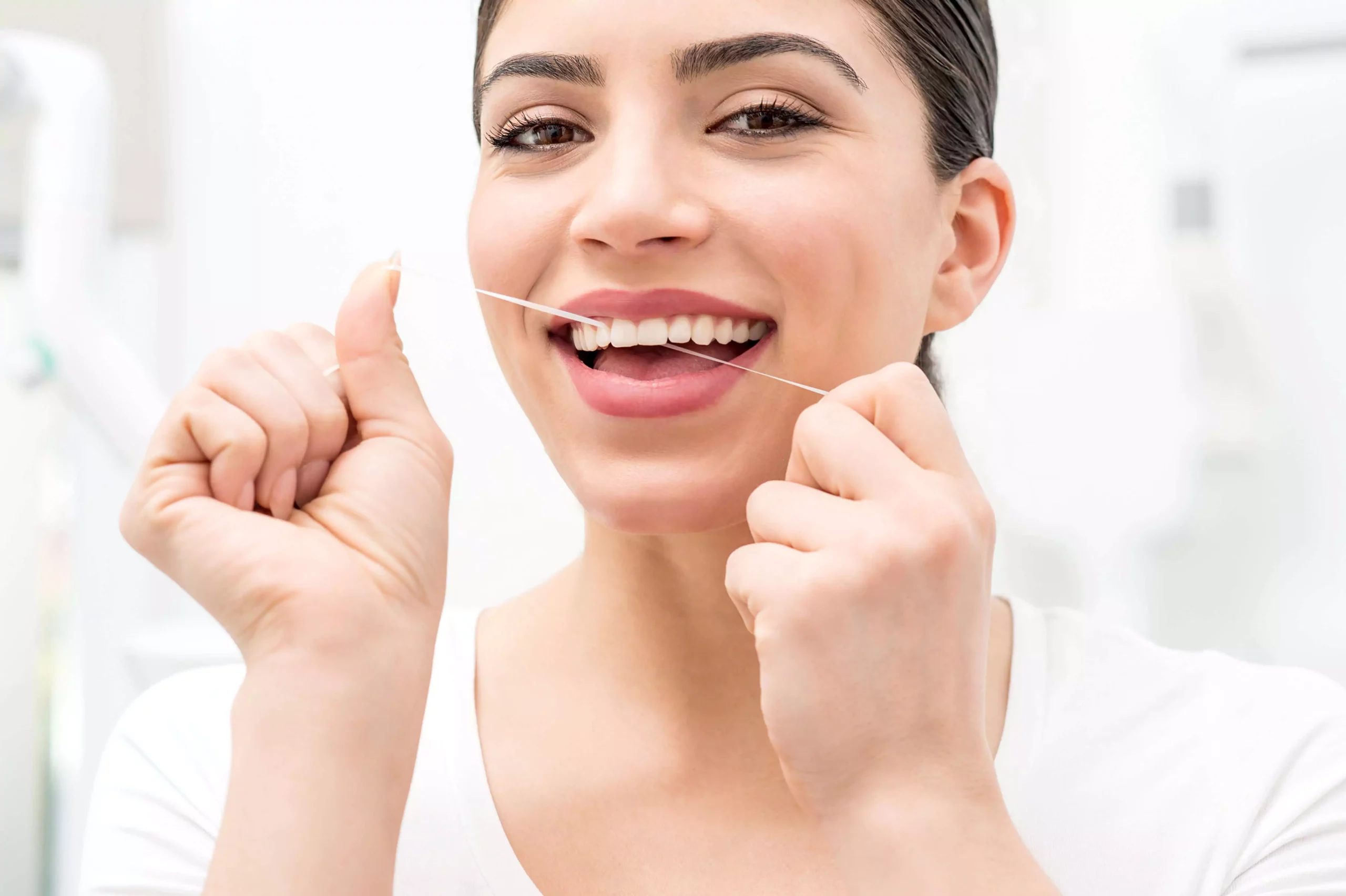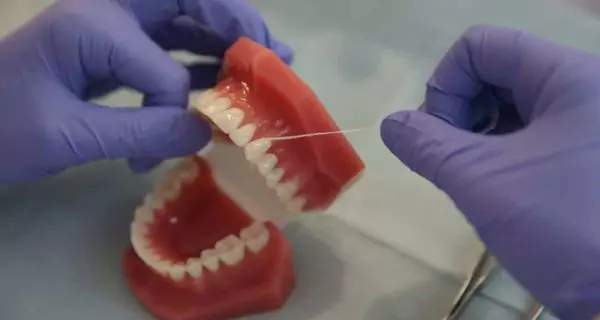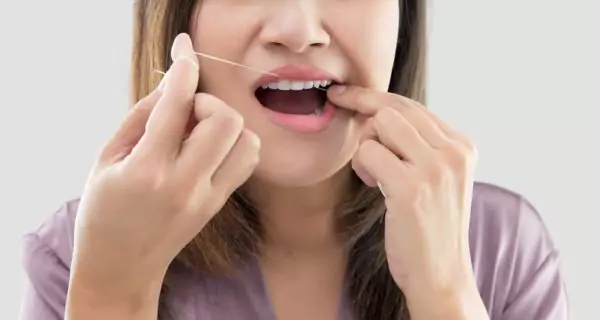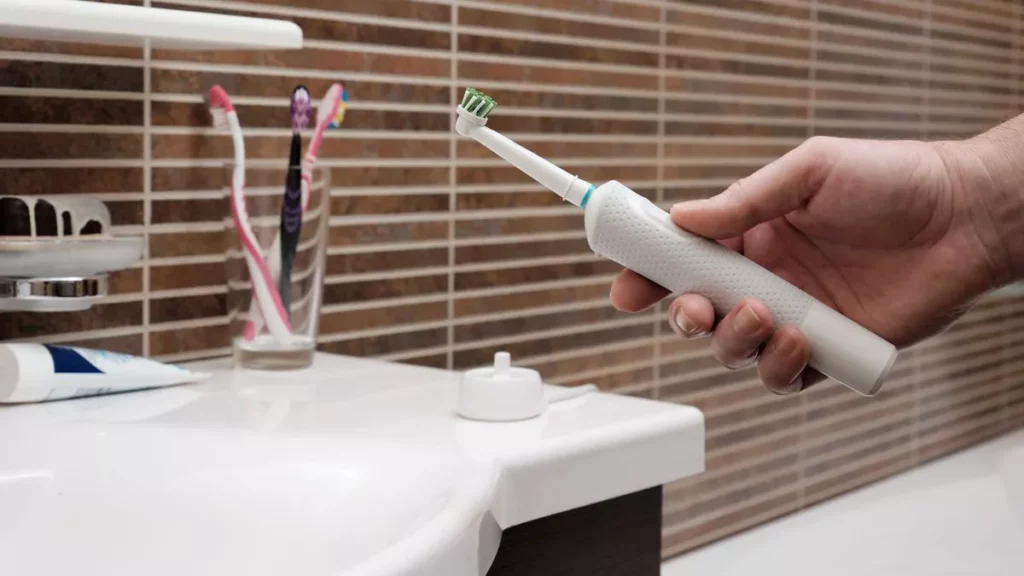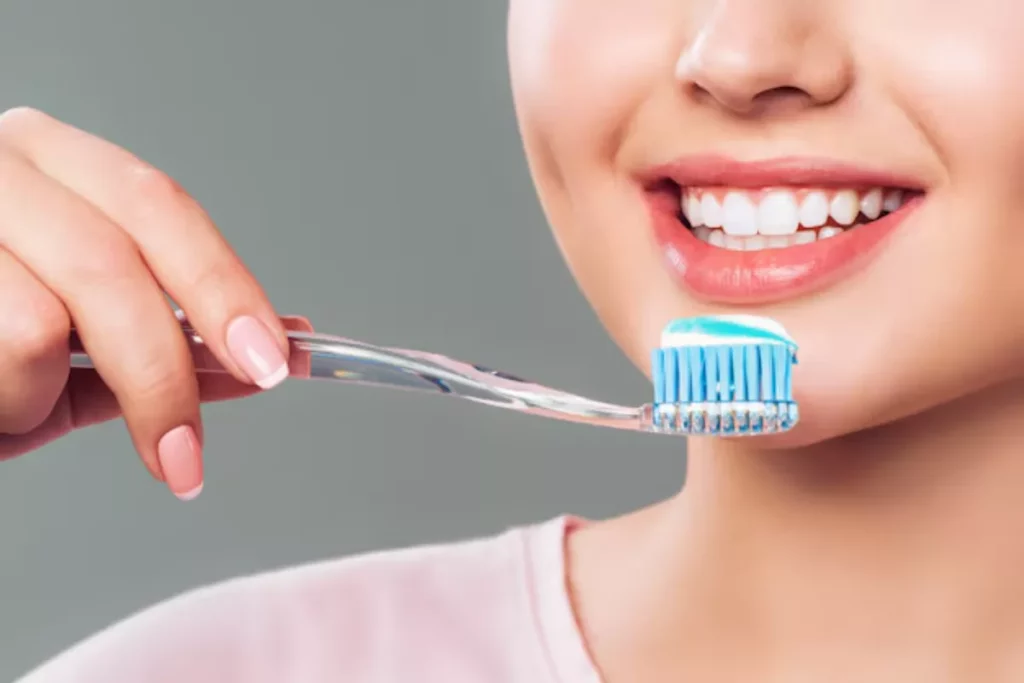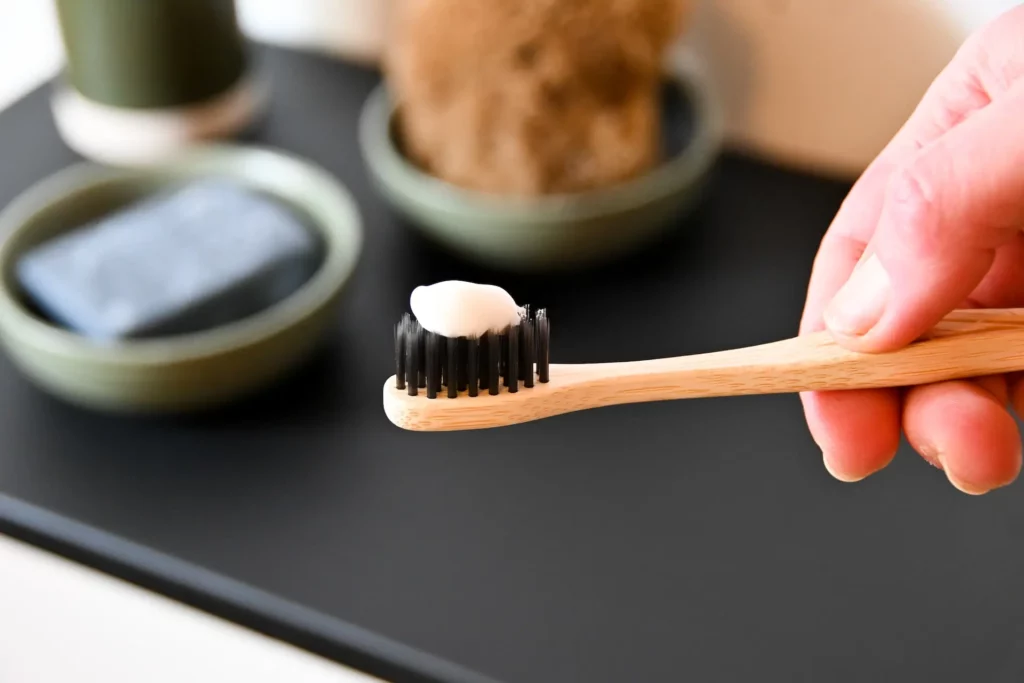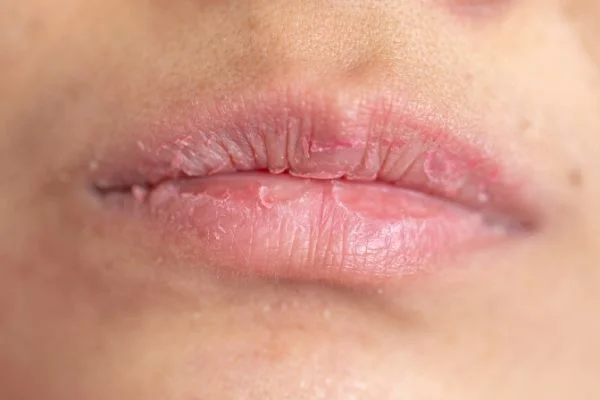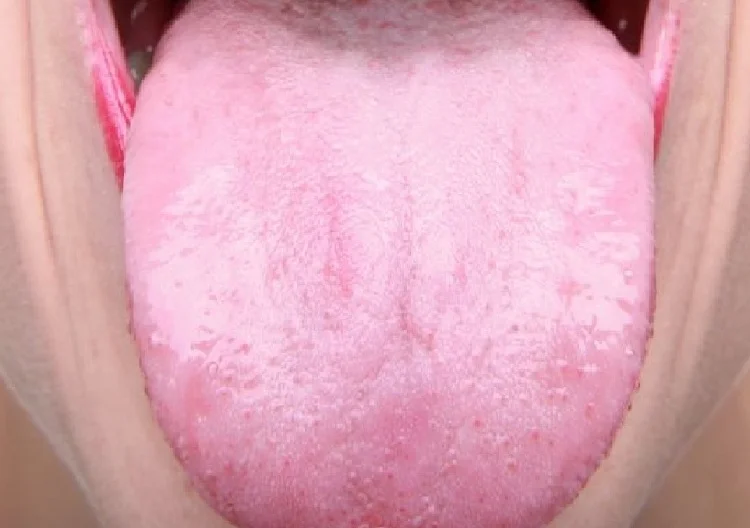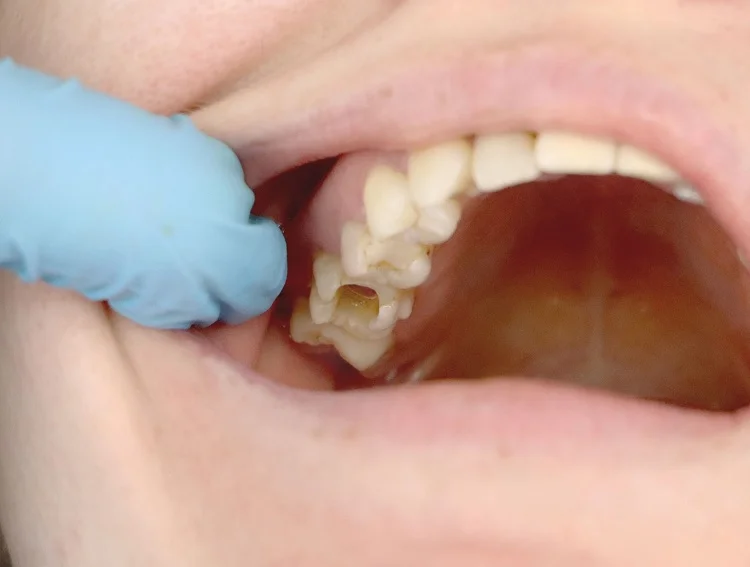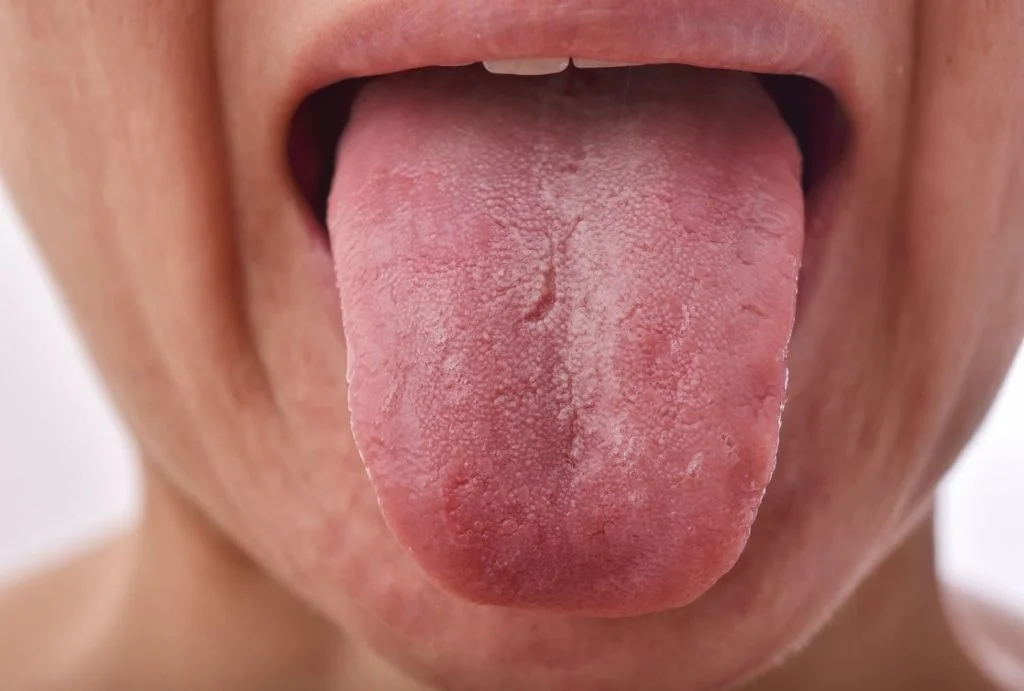Last Updated on: 23rd December 2025, 10:49 am
Flossing properly means gently sliding dental floss between each tooth, curving it into a “C” shape under the gumline, and cleaning both sides of each tooth. It’s important to be gentle to avoid injuring the gums and to use a fresh section for every tooth.
Flossing is a fundamental part of an oral hygiene routine; however, it is often one of the habits people find most tedious or difficult to maintain. For this reason, many individuals choose not to floss at all.
However, flossing is not an optional step; learning how to do it properly means that you’re not only cleaning the surfaces you can see but also protecting the hidden, more vulnerable areas between your teeth and under the gumline.
Why should I floss every day?
Brushing your teeth only covers about 60% of the tooth surface. The other 40% are the tight spaces between teeth and below the gumline – exactly where plaque, food particles, and bacteria hide.
What are the benefits of flossing every day?
Flossing daily is not optional; it’s a very important part of complete oral hygiene, which protects both oral and overall well-being. Let’s see why.
Benefits of flossing to oral health
- Prevents cavities and gum disease: Flossing removes plaque and food particles that brushing alone can’t reach, lowering the risk of cavities, gingivitis, and periodontal disease.
- Strengthens and protects gums: By cleaning under the gumline, flossing helps gums stay firm and reduces bleeding over time.
- Keeps breath fresh: Removing trapped food debris prevents bad odors makes flossing one of the simplest ways to maintain fresh breath.
- Stops plaque from hardening into tartar: Flossing daily prevents plaque buildup from calcifying into tartar, which requires professional cleaning to remove.
General health benefits of flossing
- Supports heart health: Studies suggest a link between gum disease and cardiovascular problems. Reducing oral bacteria and inflammation helps lower the risk.
- Reduces inflammation in the body: Oral bacteria can spread through the bloodstream, contributing to systemic inflammation. Flossing helps minimize this risk.
- Improves quality of life: Healthy teeth and gums make it easier to eat, speak, and smile with confidence, contributing to overall well-being.
In short, flossing daily is a small habit with big rewards. By protecting your teeth and gums, you’re also protecting your overall health.
What are the most common mistakes when flossing?
Many people floss, but not always correctly. If you want to enjoy all its benefits, it’s important to do it properly. Some of the most common errors include:
- Not flossing daily: using floss only when food is stuck is not enough. Plaque builds constantly, so consistency is important.
- Forcing the floss: Snapping floss into the gums can cause bleeding and discourage you from continuing.
- Neglecting tooth surfaces: Simply sliding floss in and out misses the plaque along the sides of each tooth.
- Skipping molars: Back teeth are harder to reach but most prone to decay.
Correcting these mistakes ensures flossing is safe and effective.
How to floss properly?
Many people say they floss “sometimes” or “before a dental visit”, but flossing once a day with the right technique is what really counts.
Let’s see a step-by-step guide on how to floss properly and see how simple it is.
Step 1 – How do you choose the right floss?
There are several types of floss; the right one depends on your teeth, gums, and preferences. Some options are:
- Waxed floss: glides more easily through tight spaces.
- Unwaxed floss: gives more grip, which some people prefer.
- Flavored floss: makes flossing more enjoyable, especially for kids.
- Expandable floss: widens when used, making it ideal for sensitive gums or larger gaps.
- Eco-friendly floss: made from biodegradable fibers for a sustainable option.
The most important thing is consistency; the best floss is the one you’ll actually use daily.
Step 2 – How do you measure and wrap the floss?
Cut about 18 inches (45 cm) of floss. Wrap most of it around the middle finger of one hand and a smaller portion around the middle finger of the other hand. Keep 1–2 inches of floss stretched tightly between your thumb and forefinger.
This setup ensures you can slide the floss comfortably and access a clean section for each tooth.
Step 3 – How should you insert the floss between teeth?
Hold the floss firmly and gently guide it between your teeth, using a back-and-forth motion. Avoid snapping or forcing it into place as this can irritate or injure the gums.
Flossing should be gentle, not something fast or rough.
Step 4 – Why should you curve the floss into a “C” shape?
Once the floss is between your teeth, curve it into a C shape around one tooth. Slide it under the gumline to clean the space most toothbrush bristles can’t reach. Then repeat the motion along the opposite tooth surface.
This curved technique ensures you’re cleaning not just the gap but also the sides of both teeth.
Step 5 – How do you clean and repeat for every tooth?
Move the floss up and down against the tooth surface to remove plaque and food particles. After finishing one tooth, roll the floss to a fresh section before moving on.
Continue until every tooth, including all back molars, is flossed. This step is crucial since these back teeth are the most cavity-prone areas.
The golden rule is to floss at least once a day. Even if your technique isn’t perfect at first, the habit itself will improve your skill over time.
Skipping flossing for weeks and then doing it before a dentist appointment won’t undo the damage caused by plaque buildup. Think of flossing as preventive maintenance, not a once-in-a-while chore.
What if I find flossing difficult?
Not everyone finds traditional string floss easy or comfortable to use. But several effective alternatives are designed to make interdental cleaning simpler and more enjoyable.
What are water flossers and how do they help?
Water flossers use a pressurized stream of water to remove plaque and food debris between teeth and below the gumline. They are:
- Gentle yet highly effective, even for sensitive gums.
- Ideal for people with braces, implants, or crowns.
- Proven to remove up to 99% of plaque from hard-to-reach areas.
They can be an excellent choice if string floss feels uncomfortable or difficult.
What are floss picks or holders?
Floss picks (also called floss holders) are small plastic tools that hold a piece of floss taut. They make flossing easier because:
- They are simple to maneuver, even in the back teeth.
- Perfect for children, beginners, or people with limited dexterity.
- Reduce finger strain and make the process more convenient.
Great for quick use on the go, though they may not wrap as fully around the tooth as string floss.
How do interdental brushes work?
Interdental brushes are tiny cylindrical brushes designed for spaces between teeth. They are especially helpful for:
- people with gum recession, braces, or dental bridges.
- wider gaps where regular floss may not clean effectively.
- those who prefer a more comfortable alternative to string floss.
They can be used daily with gentle back-and-forth strokes.
What about other options?
- Dental tape: a wider, flatter version of floss that works better in larger gaps.
- Floss threaders: small loops that help guide floss under braces, bridges, or retainers.
- Natural sticks (miswak): a traditional antibacterial option, more of a supplement than a replacement.
The most important step is finding a tool you’ll use consistently. Always check with your dentist before switching methods, as they will recommend the best option for your individual needs.
Should kids floss?
Yes, children should begin flossing as soon as two teeth touch. At this stage, food particles can get stuck and bacteria can start forming plaque.
- Parents should do the flossing for younger kids since their motor skills aren’t developed sufficiently.
- Around age 7–8, most kids can start flossing on their own with supervision.
- Floss picks or colorful kid-friendly flossers will make the process less intimidating.
- Building the habit early sets the foundation for lifelong oral health.
Pediatric dentists emphasize that kids who floss regularly grow up less afraid of dental visits and experience fewer cavities.
Is flossing the missing step in your oral care?
Brushing alone can’t reach every surface of your teeth, which is why learning how to floss properly makes such a difference.
With just a few minutes a day, you can protect your gums, prevent cavities, and keep your breath fresh. Flossing may seem small, but it’s the step that completes your oral care routine and supports overall health for many years.
Frequently Asked Questions
How often should I floss?
You should floss at least once a day. Plaque starts forming within hours, and if not removed, it can harden into tartar that brushing alone cannot eliminate. Flossing daily helps keep both teeth and gums healthy.
Is it better to floss before or after brushing?
What if my teeth are very close together?
How long should flossing take?
Is bleeding normal when I start flossing?
Voice and Search (Q&A)
Can flossing help with bad breath?
Yes, removes trapped food and bacteria between teeth, the common causes of bad breath.
Can I floss with braces or dental work?
Yes, floss threaders, water flossers, or specially designed floss picks make it easier to clean around braces, implants, and bridges.
Is flossing necessary?
Yes, flossing cleans areas that a toothbrush can’t reach and helps prevent cavities, gum disease, and bad breath.
Share
References
1. AlMoharib, H. S., Alqasem, A., Almusfer, G., Aldosari, M. A., & Almadhoon, H. W. (2024). The effectiveness of water jet flossing and interdental flossing for oral hygiene in orthodontic patients with fixed appliances: a randomized clinical trial. BMC Oral Health, 24(1). https://doi.org/10.1186/s12903-024-04166-0
2. Cleveland Clinic. (2024, November 13). How to properly floss your teeth. Cleveland Clinic. https://health.clevelandclinic.org/how-to-floss-your-teeth
3. Higuera, V. (2020, January 8). What’s the best way to floss your teeth? Healthline. https://www.healthline.com/health/how-to-floss
4. Marchesan, J., Byrd, K., Moss, K., Preisser, J., Morelli, T., Zandona, A., Jiao, Y., & Beck, J. (2020). Flossing Is Associated with Improved Oral Health in Older Adults. Journal of Dental Research, 99(9), 1047–1053. https://doi.org/10.1177/0022034520916151
5. The Healthline Editorial Team. (2019, March 8). Everything you need to know about dental and oral health. Healthline. https://www.healthline.com/health/dental-and-oral-health
-
Dr. Yeidy Carolina Mesa [Author]
DDS Yeidy Carolina Mesa Passionate Dentist | Advocate for Accessible Oral Health Education Graduating from Universidad CES in 2022, I am a dedicated general dentist with a lifelong passion for helping others and making a meaningful impact in the world. My journey into dentistry began at the age of 7, inspired by my own experience with braces and overcoming a fear of the dentist. This personal journey shaped my mission to help patients conquer their own dental anxieties and embrace a healthier,...
View all postsRecent Posts
-
Nayibe Cubillos M. [Medical Reviewer]
Pharmaceutical Chemestry |Pharmaceutical Process Management | Pharmaceutical Care | Pharmaceutical Services Audit | Pharmaceutical Services Process Consulting | Content Project Manager | SEO Knowledge | Content Writer | Leadership | Scrum Master
View all posts
A healthcare writer with a solid background in pharmaceutical chemistry and a thorough understanding of Colombian regulatory processes and comprehensive sector management, she has significant experience coordinating and leading multidisciplina...


